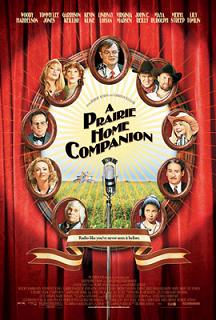
I've only been a fan of Garrison Keillor since 1993. I got a late start. But when I drove off to college without a radio in my car I needed something to play in my walkman to pass the time. I found some Lake Wobegon tapes unopened (still in the cellophane) sitting in the closet next to my mother's never used cow-shaped cream dispenser. Apparently she was unwilling to indulge in Middle America camp. Always the daring one I grabbed them to see what all the fuss was about (I left the cream dispenser there). Keillor's heavy breathy baritone combined with the folk-guitar hymn interludes kept me rapt for the entire drive as I left home.
The stories were perfect for either driving or falling asleep. The tension created by the backward tug of nostalgia and the forward thrust of adventure was perfect for either a drowsy or restless spirit. I started to hear cynicism in the stories. It was about a completely typical unreal place. The rebellious in the town were the most naive. The most settled were the most open minded. The most sheltered were the most capable. The most religious were the most realistic.
The story of a priest and a minister lamenting the silliness of their parishioners was a personal favorite.
That same year I beheld the ultimate legitimization of Keillor. A Simpsons parody. After a story about Badger Falls the Keilloresque raconteur's voice so bores and frustrates the family that Homer pounds on the television blaming it for the lack of entertainment "Stupid TV! Be more funny!"
Likewise many have blamed the tinniness of radio for limiting Keillor's cultural importance. His novels are amusing at best. He does better with the essay. The elegiac epic Lake Wobegon Days (I don't call it a novel) reads more like a grand dissociative patchwork of historical essay, short story and indulgent memoir. His greatest consistency away from the modulated frequencies of his Prairie Home Companion has come on the glossy pages of the literary magazines that gave him his start - most notably The New Yorker.
 And so readers have never known what to count on from him. Least of all would they have expected his recent movie collaboration with Robert Altman. Especially those fans who have seen him and so understand why he works away from the camera. I didn't know what to expect even though I've seen him perform his show twice - once in Ann Arbor, Michigan and once in West Lafayette, Indiana. I wanted to see how he'd represent his show as a fictional event - and for a seeing audience a little larger and much more diverse than a Big Ten town.
And so readers have never known what to count on from him. Least of all would they have expected his recent movie collaboration with Robert Altman. Especially those fans who have seen him and so understand why he works away from the camera. I didn't know what to expect even though I've seen him perform his show twice - once in Ann Arbor, Michigan and once in West Lafayette, Indiana. I wanted to see how he'd represent his show as a fictional event - and for a seeing audience a little larger and much more diverse than a Big Ten town.
The movie was fun. The pacing and style were familiar and comforting. I laughed at the jokes which were composed and organized much like his usual. Dusty and Lefty put some welcome dirt on the stage in good performances by Woody Harrelson and John C. Reilly. Lindsay Lohan plays an easy role well. Lily Tomlin acts snitty and isn't given much more to do. Too bad because I'm sure she could. Kevin Kline is fine as Guy Noir. I'm willing to admit that Keillor's voice has inhabited that character long enough to keep me from being impartial.
And at the extremes we have Virginia Madsen and Meryl Streep. I'm not sure why Madsen's character is necessary. Her angelic glow and serene consuetude grow tiresome early. She does little other than glide around easily. Perhaps Keillor is frustrated with his audience assuming everything he does is non-fiction. Without the peripatetic angel on screen some might believe the movie is a completely true account. Her presence brings in the chimeric. Pity. His work has never needed it before. In this case it is a shoestring contribution to the plot.
But Streep is good. really really good. A heavier adjective would sully her chaste and readable performance. Her accent is of an exact rhythm and timbre. She sings beautifully. She is the anchor of humour tragedy and familiarity that every Altman film needs to pivot on as it swirls around from scene to scene.
In the end I found myself most happy with one major decision regarding the eventline. The story courteously elides the news from Lake Wobegon. To include it would turn the entire movie into a vehicle for the popular segment. To sidestep it allows the process to have a point. To introduce a smaller narrative might encourage us to hold the frame to a same standard of unfolding and resolution. As is, the big unanswered question at the end of the movie is a gimmick that can humanely be disregarded (but almost everyone will get caught up in the "which one do you think it was?" game).
If you haven't liked Keillor up to now you can safely assume this movie is not for you. Like anyone talking about himself - if you don't know him his stories will likely be tiresome. If you know and like him - his stories need no plot.





